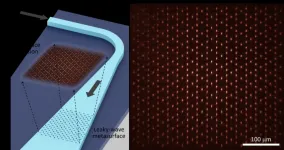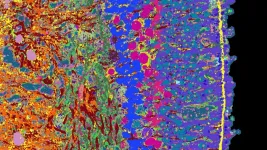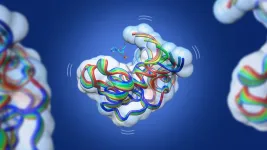(Press-News.org) Going beyond pregnancy and COVID-19, the world could someday soon come to rely on at-home tests for many diseases thanks in part to AI-fueled improvements.
University of Florida scientists have used artificial intelligence tools to simplify a test that works for both hepatitis C and SARS-CoV-2, the virus that causes COVID-19. The simplified test happens in one small test tube in just a few minutes. With further refinement, it could come to doctor’s offices soon and, one day, even home tests that are as easy as a pregnancy test.
“We are trying to build a home-based test that is as reliable as a lab-based test,” said Piyush Jain, a UF professor of chemical engineering who led the latest research. “We are trying to make the test simple, eliminate the need for expensive equipment and provide results in just 10 to 20 minutes.”
To accomplish those goals, Jain’s group is innovating on a system known as a one-pot reaction, because the entire test happens in one small test tube. These tests, based on a technology known as RT-LAMP, can amplify small portions of a virus’s genome and produce a visible signal when it detects the virus. Reading these tests can be as simple as looking for a blue color or using a small device that detects a change in the test tube.
The FDA has approved some at-home, one-pot tests for COVID-19, as a part of the emergency use authorization, but they have a relatively high false positive rate, meaning they aren’t as reliable as they could be.
“We are combining another technology called CRISPR to determine the difference between a false positive and a true positive,” Jain said.
CRISPR has become known in the biotech world for its ability to drive rapid genetic engineering improvements, which have the potential to one day cure inherited diseases by repairing genomes. Jain’s group relies on the CRISPR system’s ability to home in on particular genetic sequences. Only if the sequence for, say, the hepatitis virus is really present will the test show a positive result.
The only problem? The RT-LAMP technology requires a temperature of 150 degrees F, while CRISPR works best at 100 degrees. That difference makes tests far more complicated requiring two separate reactions– too complicated for at-home use. Jain’s team has been trying to bridge this gap by developing a CRISPR system that can withstand higher temperatures.
From a heat-loving species of bacteria, the researchers recently discovered a CRISPR enzyme that thrives at 140 degrees. In their latest work, Jain’s group turned to AI tools to analyze this enzyme and discover how they could make it survive at 150 degrees. The AI programs suggested a few dozen changes to the enzyme, which Jain’s group tested in the lab. They eventually found four changes to the enzyme that let it work at 150 degrees.
“It’s very challenging for any human to do this kind of analysis on an enzyme. We didn’t have to spend years, we could make these improvements in months,” Jain said. “With everything working at the same temperature, now we are able to combine everything in a true one-pot reaction, we call SPLENDID.”
The team verified their simplified SPLENDID test on clinical samples from patients with hepatitis C or COVID-19. The test was 97% accurate for SARS-CoV-2 and 95% accurate for the most prevalent version of the hepatitis C virus found globally. Although it didn’t work well against all other less predominant versions of the hepatitis C virus, straightforward changes to the test should quickly improve its accuracy, Jain says. His team published their findings May 8 in the journal Cell Reports Medicine.
The work was funded by the National Institute of Allergy and Infectious Diseases at the National Institutes of Health in hopes of developing simple tests for viruses like hepatitis C so they can be identified and treated early, when treatments work best. Jain’s group will now work to refine the test, improve its ability to distinguish between hepatitis C strains and verify it in hospital settings in hopes of one day providing at-home tests as well.
END
AI helps create better, simpler hepatitis, COVID-19 tests
2023-05-08
ELSE PRESS RELEASES FROM THIS DATE:
Leaky-wave metasurfaces: A perfect interface between free-space and integrated optical systems
2023-05-08
New York, NY—May 8, 2023—Researchers at Columbia Engineering have developed a new class of integrated photonic devices--“leaky-wave metasurfaces”--that can convert light initially confined in an optical waveguide to an arbitrary optical pattern in free space. These devices are the first to demonstrate simultaneous control of all four optical degrees of freedom, namely, amplitude, phase, polarization ellipticity, and polarization orientation--a world record. Because the devices are so thin, transparent, and compatible with photonic integrated circuits ...
AI predicts future pancreatic cancer
2023-05-08
An artificial intelligence tool has successfully identified people at the highest risk for pancreatic cancer up to three years before diagnosis using solely the patients’ medical records, according to new research led by investigators at Harvard Medical School and the University of Copenhagen, in collaboration with VA Boston Healthcare System, Dana-Farber Cancer Institute, and the Harvard T.H. Chan School of Public Health.
The findings, published May 8 in Nature Medicine, suggest that AI-based population screening could be valuable in finding those at elevated risk for the disease and could expedite the diagnosis of a condition ...
Tiny microbes could brew big benefits for green biomanufacturing
2023-05-08
A research team led by Lawrence Berkeley National Laboratory (Berkeley Lab) and UC Berkeley has engineered bacteria to produce new-to-nature carbon products that could provide a powerful route to sustainable biochemicals.
The advance – which was recently announced in the journal Nature – uses bacteria to combine natural enzymatic reactions with a new-to-nature reaction called the “carbene transfer reaction.” This work could also one day help reduce industrial emissions because it offers sustainable ...
Human Brain Project: Study presents large brain-like neural networks for AI
2023-05-08
In a new study in Nature Machine Intelligence*, researchers Bojian Yin and Sander Bohté from the HBP partner Dutch National Research Institute for Mathematics and Computer Science (CWI) demonstrate a significant step towards artificial intelligence that can be used in local devices like smartphones and in VR-like applications, while protecting privacy. They show how brain-like neurons combined with novel learning methods enable training fast and energy-efficient spiking neural networks on a large scale. Potential applications range from wearable AI to speech recognition and Augmented Reality.
While modern artificial neural ...
Detailed image of the human retina
2023-05-08
What cell types are found in which human tissue, and where? Which genes are active in the individual cells, and which proteins are found there? Answers to these questions and more are to be provided by a specialised atlas – in particular how the different tissues form during embryonic development and what causes diseases. In creating this atlas, researchers aim to map not only tissue directly isolated from humans, but also structures called organoids. These are three-dimensional clumps of tissue that are cultivated in the laboratory and develop in a way similar ...
Welcoming Dr Ece Uzun, MS, PhD as the Editor-in-Chief for JMIR Bioinformatics and Biotechnology
2023-05-08
JMIR Bioinformatics and Biotechnology and JMIR Publications are thrilled to announce and welcome Dr Ece Uzun as Editor-in-Chief for JMIR Bioinformatics and Biotechnology.
Dr. Uzun is currently the Director of Clinical Bioinformatics and Associate Director of Clinical Cancer Informatics and Data Science (CCIDS) at Lifespan and an Assistant Professor of Pathology and Laboratory Medicine at Brown University Alpert Medical School. She has a B.S in Chemical Engineering and M.Sc in Biological Sciences and Bioengineering. She completed her PhD in Chemical Engineering at Northeastern University in 2010 and focused ...
Elucidating the mysteries of enzyme evolution at the macromolecular level
2023-05-08
Professor Nicolas Doucet and his team at Institut national de la recherche scientifique (INRS) made a major breakthrough earlier this year in the field of evolutionary conservation of molecular dynamics in enzymes. Their work, published in the journal Structure, points to potential applications in health, including the development of new drugs to treat serious diseases such as cancer or to counter antibiotic resistance.
As a researcher specializing in protein dynamics, Professor Doucet is captivated by things that are invisible to the naked eye, yet full of mysteries and essential to all forms of life. He studies proteins ...
Recent research advances on historical artifacts and their preservation
2023-05-08
Because we don’t have crystal balls to show us how the world used to look, scientists must rely on preserved artifacts and specimens to provide the details. Below are some recent papers published in ACS journals that have unearthed insights from historic items and provided suggestions for protecting relics. Reporters can request free access to these papers by emailing newsroom@acs.org.
“Two Pathways for the Degradation of Orpiment Pigment (As2S3) Found in Paintings”
Journal of the American Chemical Society
April 14, 2023
Oil paintings created before the 19th century often ...
Chinese Medical Journal review highlights the health hazards of air pollution
2023-05-08
Globally, air pollution is a major public health hazard. A key air pollutant linked to health risks is ambient fine particulate matter (PM2.5), which consists of minute particles, sized less than or equal to 2.5 μm, suspended in the air. According to the WHO, annual PM2.5 levels should not exceed 5 μg/m3. However, the current PM2.5 levels in China far exceed this standard and are responsible for approximately 1.4 million PM2.5-related excess deaths annually. Even as the country steadily works towards reducing ...
Researchers Identify the Standard for Gallbladder Cancer Surgery
2023-05-08
(Boston)—The quality of surgery can drastically influence both short- and long-term postoperative outcomes and is a crucial consideration in studies that assess surgical outcomes. One approach for developing accurate quality measures is benchmarking, a quality-improvement process in which the best possible outcomes are identified to serve as a point of reference against which performance can be compared.
Surgery for gallbladder cancer (GBC) is a technically challenging surgical procedure and requires considerable expertise ...




